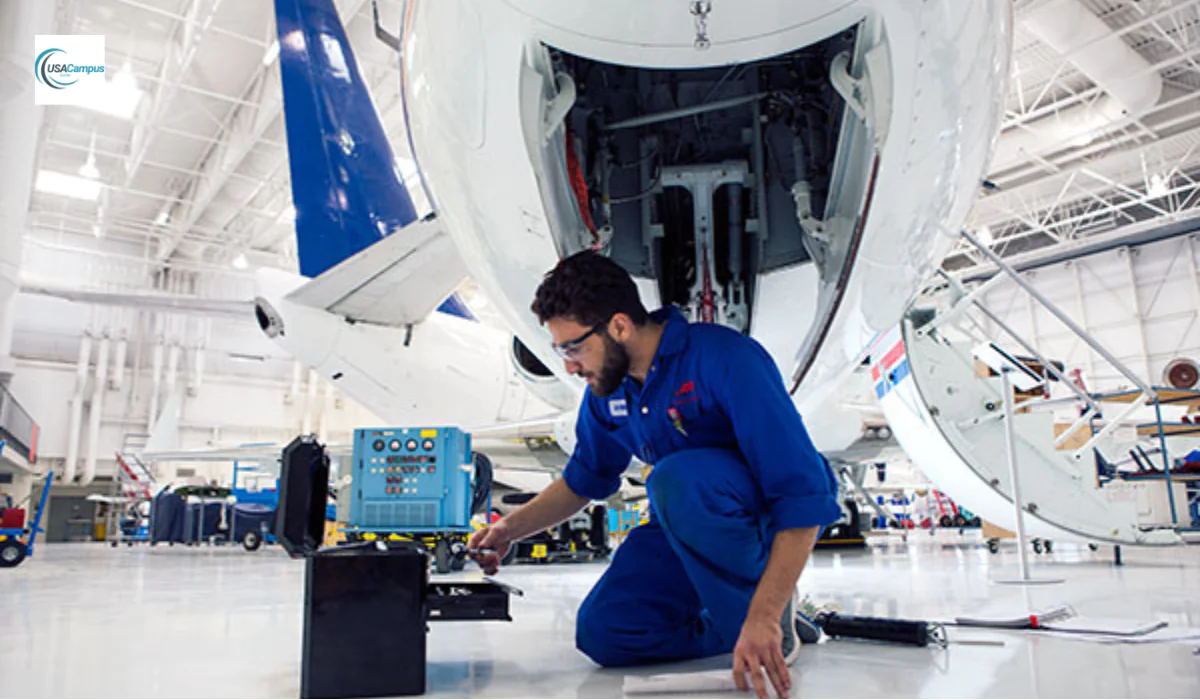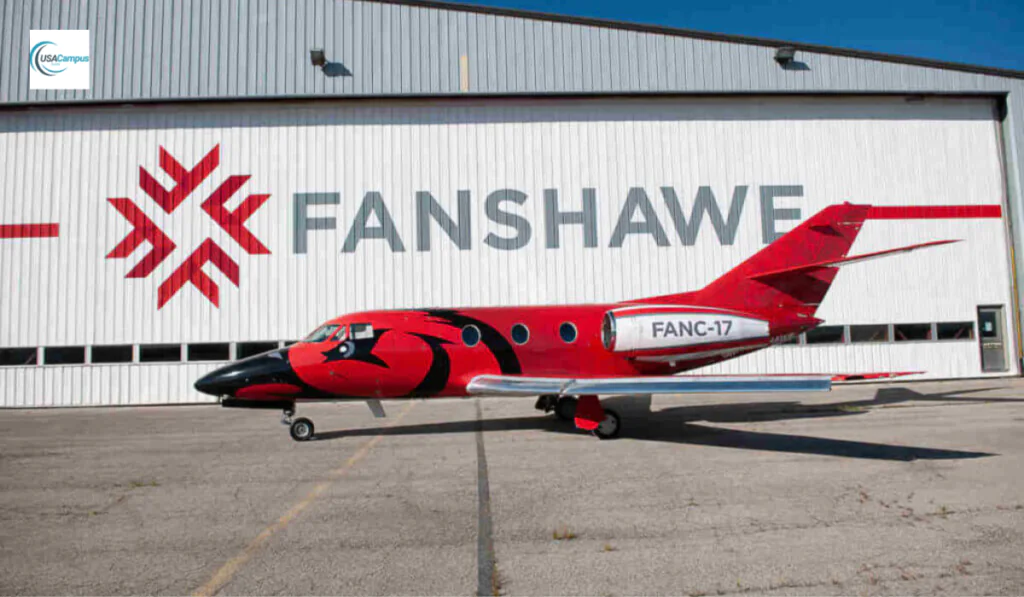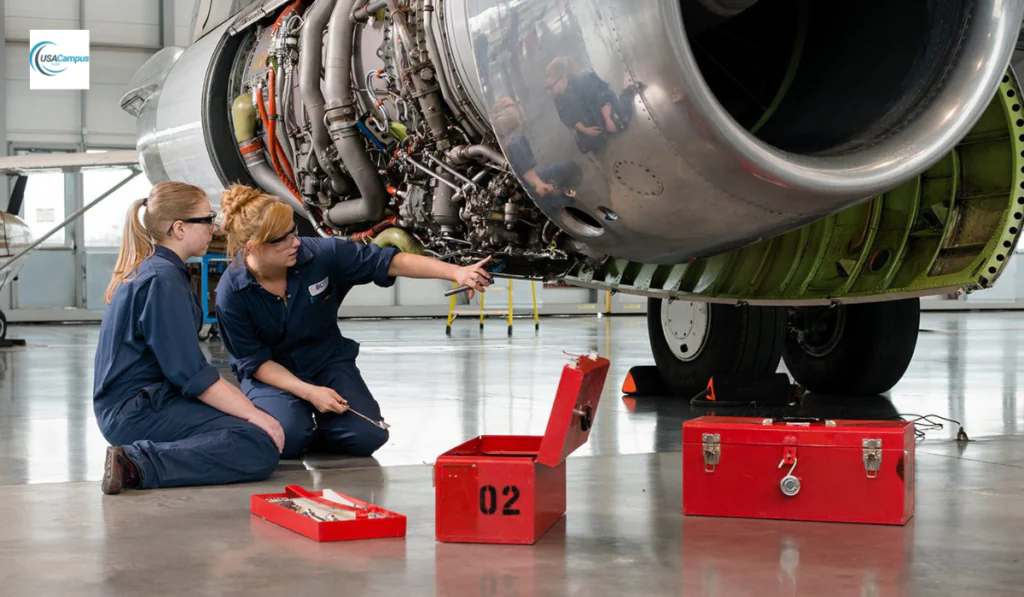Can you fix things with ease and have an affection for flying? So, then you might be well-suited for a job as an Aircraft Maintenance Engineer. If you’re looking for a new and exciting career, this blog post will go over seven good reasons why you should consider becoming an aircraft maintenance engineer.
Your future in this field is bright, Thanks to high demand and plenty of room for development.
What is Aircraft Maintenance Engineer?
Aircraft Maintenance Engineers are skilled at ensuring aircraft safety and airworthiness. Inspection, repair, and maintenance of aircraft components are crucial to their proper operation. These engineers can diagnose and fix mechanical, electrical, and structural problems during operations.

Airplane Maintenance Commercial planes, helicopters, and military jets are all engineered. To ensure industry-leading safety, they must follow strict aviation regulations. Preventing flight-threatening malfunctions which requires immense expertise.
Aircraft Maintenance Engineers improve aviation system reliability and efficiency with their expertise and hands-on experience. Their meticulousness, precision and high knowledge and skills required about the subjects makes them mandatory for any airline or aerospace company.
Importance of Aircraft Maintenance Engineers in the aviation industry
Aircraft Maintenance Engineers (AMEs) are extremely vital part of the aviation business as they make sure planes are safe, reliable, and follow the rules. Their main job is to keep planes safe and ready to fly by inspecting, maintaining, and fixing them on a regular basis.
Lots of different things need to be done for this to work, from regular checks and fixing problems to big overhauls and system upgrades. AMEs help keep accidents from happening by finding and fixing possible problems before they get too bad. AME’s ensure that repair activities are legal and follow strict aviation rules because of which airlines are able to run ethically.
Maintaining aircraft in good shape is another way that AMEs help airlines be more cost-effective and efficient. They do this by lowering down on downtime and making aircraft parts last longer. Their knowledge and careful attention to detail make passengers feel safe and protect the aviation industry’s image.
Role and Responsibilities
Aircraft Maintenance Engineers (AMEs) play very crucial role to the aviation business because they make sure that planes are safe and can fly. They are mostly responsible for regular and emergency maintenance, thorough inspections, finding and fixing problems, and giving the go-ahead for planes to fly.
AMEs take apart, check, test, fix, and put back together airplane engines and systems, such as communication and electrical circuits. They have to follow strict safety and legal rules, keep thorough records of all maintenance work, and often are in charge of people with less experience.
To do their important and complicated jobs in aircraft repair well, AMEs need special training, certification, and a lot of attention to detail.
Overview of the duties of an Aircraft Maintenance Engineer
It is Aircraft Maintenance Engineer’s (AME) duty to ensure that planes are safe and can fly by carefully inspecting, maintaining, and fixing them. They are responsible for varied duties like taking apart, inspecting, testing, fixing, and putting back together airplane engines and parts.
They set up and test electrical circuits, communication systems, and computer systems. They inspect the engines and mechanical systems regularly before every flight. AMEs maintain detailed records of all maintenance work, buy parts and supplies as needed, and make sure that all safety rules and regulations set by aviation authorities are followed.
Best Online Course on Cyber Security in Canada
Best Online Cyber Security Courses in Canada
Importance of ensuring aircraft safety and compliance with regulations
Aviation safety and compliance are crucial due to the high stakes. Safety is the top priority because any safety breach can have dire consequences for passengers and crew.
Following strict safety protocols and regulatory standards set by the FAA and ICAO helps prevent accidents and incidents, strengthening public trust in air travel.
Aviation companies reduce legal and financial risks by following these regulations, ensuring operational efficiency and reputation. These standards require ongoing training and a strong safety culture to promote safety at all levels.
Collaboration with other professionals in the aviation industry
Aircraft Maintenance Engineers (AMEs) are crucial to aircraft safety and airworthiness. Their collaboration with other aviation professionals is necessary for efficient operations. They also work with air traffic controllers to schedule maintenance without disrupting flights.
AMEs also work with technicians and engineers to inspect, repair, and overhaul equipment, sharing knowledge to solve complex technical issues. Teamwork with regulators ensures safety standards and regulations are met. These diverse professionals must communicate and collaborate to meet aviation safety standards.
Admission Requirements for becoming aircraft maintenance engineer in Canada
To become an Aircraft Maintenance Engineer (AME) in Canada, you must meet specific qualifications and undergo extensive training. Here are the key requirements and steps involved:
Basic Qualifications
- Age: You must be at least 21 years old to apply for an AME license.
- Education: Completion of secondary school is required. Additionally, a college diploma in aircraft maintenance or completion of a four-year apprenticeship program is usually necessary even for international students.
Training Programs
- Transport Canada-Approved Training: You must complete a basic training program approved by Transport Canada or one that is acceptable to Transport Canada. These programs are typically offered by vocational colleges and include both theoretical and practical components.
Specific Aircraft Maintenance Engineer Course:
Fanshawe College
Offers an Aviation Technician – Aircraft Maintenance (Co-op) program. Fanshawe College in London, Ontario, offers a two-year Aviation Technician – Aircraft Maintenance (Co-op) program. This Transport Canada-approved program includes cooperative education to give students industry experience.
This program is available to international applicants too. The program covers all aircraft maintenance, including general aviation, corporate aviation, and transport category systems. Graduates can get fixed-wing or rotary-wing aircraft maintenance licenses and work for Canadian and international companies.

Centennial College
Provides an Aircraft Maintenance – Aviation Technician program. Centennial College in Toronto is a top aircraft maintenance school. Transport Canada and the Canadian Council for Aviation and Aerospace accredit the college’s Aviation Technician – Aircraft Maintenance program.
This program is designed for students to maintain and repair fixed wing aircraft and rotary wing aircraft. Our curriculum covers aerodynamics, mechanical, electrical, and electronic principles of aircraft systems.
Southern Alberta Institute of Technology (SAIT)
Offers an Aircraft Maintenance Engineers Technology program. Calgary’s Southern Alberta Institute of Technology (SAIT) offers Aircraft Maintenance Engineers Technology. Students learn aircraft maintenance and repair skills in this Transport Canada-approved program.
SAIT’s emphasis on practical training and industry partnerships prepares graduates for aviation careers.
British Columbia Institute of Technology (BCIT)
Program offers studies in avionics, maintenance, structures, and aircraft gas turbine engine technology. The institute is known for its state of the art facilities and strong industry connections, providing students with excellent training and career opportunities in the aviation sector.
Confederation College
Confederation College in Thunder Bay, Ontario, offers Aviation Technician – Aircraft Maintenance. This Transport Canada-approved Ontario College Diploma program teaches students to inspect, test, troubleshoot, and repair aircraft systems and components
Mohawk College
The Transport Canada-compliant program includes extensive hands on practical training in well-equipped labs and aircraft hangars. Airframe systems, aircraft construction, electrical and electronic systems, and more prepare students for a successful aircraft maintenance career.
Northern Lights College
Northern Lights College in Dawson Creek, BC, offers Transport Canada-approved Aircraft Maintenance Engineering. Students learn how to maintain large and small airplanes and helicopters to become licensed Aircraft Maintenance Engineers. The college emphasizes practical training and industry partnerships to prepare students for jobs.
Red River College
At its Stevenson Campus, Winnipeg-based Red River College offers an Aircraft Maintenance Engineer program. The Transport Canada-compliant program teaches students to inspect, repair, and maintain aircraft systems. Strong industry partnerships and state-of-the-art facilities ensure top-notch training and aviation career readiness at the college.
Canador College
Canadore College in North Bay, Ontario, offers a Transport Canada-approved Aircraft Maintenance Technician program. The program teaches students how to maintain and repair aircraft systems and components. Canadore College’s hands-on training and industry connections prepare graduates for aviation careers.
Experience and Skill Development
- Practical Experience: You need to gain a total of 48 months of applicable civil aviation maintenance experience. This includes performing specific maintenance tasks to develop necessary skills.
- On-the-Job Training: Several years of on-the-job training are required for aircraft mechanics. This experience is crucial for developing practical skills and meeting the maintenance task requirements.
Examinations
- Technical and Regulatory Exams: You must successfully complete the technical and regulatory exams administered by Transport Canada. These exams test your knowledge and understanding of aircraft maintenance and aviation regulations.
- Study Guides: Transport Canada provides study and reference guides to help you prepare for these exams.
Application Process
- Documentation: Submit an application with the correct form and all required documentation, including proof of citizenship, age, training, experience, and skill.
- Submission: Applications can be submitted in person, by mail, or electronically to your nearest Transport Canada Centre.
Licensing and Certification
- AME License: Upon meeting all the requirements, you will be granted an AME license, which is valid for ten years and can be renewed. The license allows you to perform and certify aircraft maintenance work.
- Ratings: The AME license can be endorsed with different ratings such as M1, M2, E, and S, depending on the type of aircraft and systems you are qualified to work on.
Hands on Practical Training in Aircraft Maintenance Tasks
Aircraft Maintenance Engineering (AME) programs demand hands-on training. Training with aircraft systems and components lets students apply theoretical knowledge in real life. With the help of industry-standard tools and equipment’s students are able to gain experience.
Practical training emphasizes safety protocols and regulatory compliance, preparing future AMEs to maintain aircraft safety and airworthiness. This hands-on experience helps develop problem-solving and teamwork skills needed for an aircraft maintenance engineering career.
Different categories of AME licenses (e.g. M1, M2, E)
- Aircraft Maintenance Engineer (AME) licenses are categorized by aircraft and systems. Canada has three main categories: M1, M2, and E.
- M1 covers gliders, small piston-powered, and small turboprop aircraft, which are lighter and non-turbojet. It covers aircraft built to CAR 522, 523, and equivalent standards but not turbojets.
- M2 covers all aircraft which are not in M1, including turbojets and larger, more complex aircraft. It also includes CAR 525, 529, and other aircraft.
- E covers aircraft communication, navigation, auto flight, and other avionics systems. The holder can maintain and certify these systems on various aircraft.
Process for renewing and maintaining AME licenses
AMEs should maintain skills through continuous professional development, which may include refresher courses, workshops, and keeping up with industry standards and technology. They must also log a certain number of aircraft maintenance hours per period.
The common renewal steps are applying to the relevant aviation authority, providing proof of training and work experience and also passing a written or practical exam.

Aircraft Systems Knowledge
An Aircraft Maintenance Engineer (AME) must understand the complex components and operations of aircraft systems. It includes avionics, hydraulics, propulsion, electrical, and environmental controls. These systems must be diagnosed, troubleshot, and repaired by an AME for aircraft safety and efficiency.
The engineer can recognize potential issues before they become critical by conducting periodic maintenance and comply with strict aviation regulations by knowing these areas. High-quality aircraft maintenance and safety demands ongoing learning and technological advancements.
Aircraft Maintenance Engineer Salary
Aircraft Maintenance Engineers in Canada enjoy competitive salaries and comprehensive benefits packages. The average salary for an AME ranges from CAD 50,000 to CAD 90,000 per year, depending on experience, location, and the specific employer.
Senior positions or those with additional certifications can command even higher salaries.
In addition to attractive salaries, AMEs often receive excellent benefits, including health care, dental plans, retirement savings plans, and paid vacation time .
Many employers also offer bonuses, overtime pay, and opportunities for further training and professional development. These financial incentives make a career as an AME not only rewarding but also financially stable.
Global Recognition and Mobility
A career as an Aircraft Maintenance Engineer in Canada offers global recognition and mobility. The AME license issued by Transport Canada is highly respected worldwide, allowing Canadian AMEs to work in other countries with similar regulatory standards . This international recognition opens up opportunities to work with global airlines, aircraft manufacturers, and maintenance organizations.
Conclusion
Pursuing a career as an Aircraft Maintenance Engineer in Canada offers numerous benefits, including high demand and job security, competitive salaries and benefits, opportunities for career advancement, global recognition and mobility, and the chance to contribute to safety and innovation. These factors make it an attractive and rewarding career choice for those interested in the aviation industry.
If you are passionate about aviation, enjoy working with advanced technologies, and want a stable and fulfilling career, becoming an Aircraft Maintenance Engineer in Canada could be the perfect path for you. With the right training and dedication, you can join a profession that not only offers excellent career prospects but also plays a crucial role in ensuring the safety and efficiency of air travel.
I am Micheal V, a freelance blog writer. I have expertise in writing blog with interest in Travel, Education, Stock Market. I can help my customers to get Ad sense Approval, You can connect with me for any blog writing service on “usacampusguide@gmail.com“, by mentioning Subject as “Blog Writing Service”
